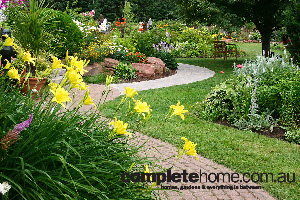In this Scott Brown-designed landscape, the jarrah decking has been left to age gracefully.
Timber decks can be used for many purposes in outdoor spaces. Whether it’s making better use of a sloping site, extending your living area, creating a safe place for kids to play or a haven for entertaining guests, timber decks are both appealing and functional.
Endless versatility
“You can create almost any shape of structure you like with a deck — multi-levelled, curved, segmented or elevated,” says Daryl Lambert from Softwoods Timberyards. “Virtually any idea can be translated into reality when using the versatility of decking.”
Garden designer Aaron Worth from Utopia Landscape Design agrees with Daryl about the infinite versatility of decking. “Decks can be incorporated into the outdoor space in a multitude of ways such as an extension of an indoor room, around a pool or as a walkway or access point,” he says. “In fact, they can satisfy every outdoor requirement and will provide a timeless and practical feature for any landscape or outdoor space.”
Decks are extremely useful in landscapes with difficult terrain, as there is reduced preparation work such as excavation, filling, levelling and retaining, which is what would be involved if you wanted to level out a stretch of land using retaining walls rather than constructing a level deck over it.
“Decks can also be used to create a landscape centrepiece, set the theme of an outdoor space or simply as a contrasting material to provide interest and natural colour,” adds Aaron.
Timber varieties
Decking boards come in many varieties of timber and what you choose will depend on your budget, the look you’re trying to achieve and the timber’s eco-credentials — but you need hardwood for something structural such as a deck.
“Merbau/kwila and kapur from sustainably managed forests are hardwoods that weather well and require minimum care,” says Daryl. “Hardwood timber decks will withstand weathering the best and are ideal in Australian conditions.”
“Correct design and construction of a deck is of the utmost importance and safety and longevity of a deck should not be compromised by using substandard timber sizes or materials,” says Aaron.
The construction of decks should be done according to standard engineering codes, says Daryl. “These dictate floor load widths and will provide a guide as to the distance you require between bearers and the sizes of your internal timbers.”
With safety and long life in mind, he also recommends: “Posts are not sunk in the ground but are fastened with hot-dipped galvanised post shoes so the structure will be impervious to the elements.”
The proper treatment
To ensure longevity as well as resistance against weathering and termite attack, many decking companies recommend using copper chrome arsenic (CCACCACCA) treated pine for the substructure, although there are environmental concerns regarding its use. These concerns lay with the toxic chemicals released if the timber should be burned at the end of its usefulness or the leaching of chemicals into landfill (and subsequently our waterways) following its eventual disposal.
Similarly, there are health concerns about prolonged exposure to CCACCACCA-treated timber, so it’s recommended that it not be used for decking boards or handrails, nor furniture or play equipment — basically for anything outdoors where people will come into regular direct contact with it.
The key message here is that you must consider your use of materials very carefully, says Aaron. “The elements, especially water, are harsh on decks, as is the threat of termites, so your deck should be designed and constructed to protect from these.” Designing a deck to make regular inspection and maintenance easy is also critical.
Maintenance matters
Unfortunately, decks often don’t last as long or perform as well as their owners would expect, says James Stubbersfield from Deck Master. This is because people sometimes just aren’t prepared to do it right from the start. “The interesting thing is that building a deck that provides long life performance requires little more investment in time and money than you would put into building a deck that performs poorly,” he adds.
According to James, problems with decks most often arise over time from errors made in the initial choice of materials or construction practices, or inadequate maintenance. “To gain good long-term performance from your deck, it’s important to use good-quality materials and construction practices and to perform regular maintenance,” he emphasises.
Not all decking timbers are the same and different decking timbers will provide different performance. “For satisfactory performance over a longer life, and in weather-exposed conditions, quality decking timber should be of appropriate durability, seasoned, stable, and preservative treated,” says James. “Suitable drainage and grading of the area under the deck should also be provided to ensure water runs away freely and the area under the deck dries quickly after rain without water pooling.”
Where regular rainfall is expected, your deck should be protected by a roof with wide overhangs.
Correct construction
“The correct fixing and fixing method are important to the satisfactory long-term performance and appearance of timber decking,” says James. “In corrosive environments, such as in coastal areas or around pools, all fixings including post supports and brackets should be stainless steel.”
Steel is being used more these days in the support and framing of decks, observes Aaron. And, although costly, it provides great structural and lifespan benefits if protected from rust. “Stainless steel is also making its way into the more visible aspects of a deck, such as cabling and balustrading,” adds Aaron.
“A timber deck is intended to provide long-term enjoyment and this can be assured if attention is given before and during construction to using good-quality timber, fasteners, finishes and construction practices and to performing regular maintenance after the deck is built,” says James.
Decks are exposed to various elements and not only do they need to be designed and constructed to withstand these elements, but they also need to be maintained accordingly to ensure their appeal and longevity. Using the appropriate finish, oil or stain on your deck will assist with this.
“It’s important that a suitable finish be applied and maintained to protect the timber from weathering and to maintain an attractive appearance,” says James.
The benefits of timber
“As well as looking beautiful, a timber deck also provides environmental benefits as wood is sustainable and stores carbon,” says Daryl. (Of course, it is only sustainable if the wood is from a legal, properly managed source.) Ric Sinclair, a spokesperson for the “Wood. Naturally Better” program agrees. “The strength, durability and versatility of wood make it an attractive and practical choice for decking.
Timber decking is also a good environmental choice because wood stores carbon even after it is turned into an attractive deck for your home,” he says. “Even after wood has been used to construct a decking, it naturally stores carbon throughout its life, acting as a major sink for carbon taken from the atmosphere. By choosing to include wood and timber products in the design of your outdoor living area, not only are you choosing a natural, durable and stylish material but you are also helping to tackle climate change.”
Furthermore, wood is available in a large range of colours, grain and texture for your deck and is cost effective. “The natural strength of timber means that decking constructed with timber will last a lifetime,” adds Ric.
Large or small
And if you think you need a large backyard for decking, think again. “The flexibility of the material and the design possibilities mean that every backyard, large or small, can benefit from the beauty of a timber deck,” says Aaron.
“Also remember that decking doesn’t have to be on the ground.” adds Daryl. “You can create a balcony or elevated area using timber decking to make the most of your space and get the most out of your home.”
And if you don’t have space for even a small deck, you can still enjoy the beauty of timber decking in other ways. “You can use decking boards to create slatted screens for privacy or you can make planter boxes out of them,” suggests Daryl. Decking boards can also be used to make a weatherproof bench for your backyard or a storage area — the choices really are limitless.
handy advice
Decks more than one metre above the ground must have deck railings, balustrades and handrails and these must comply with the Building Code of Australia (BCACA). Handrails can be made of many different materials, including stainless steel and timber, or a mix of two. Styles can range from timber slats to tensioned cable.
eco tip
Opt for an Australian species that comes from a sustainable source or check the origin of any imported timbers. Look for timber decking that has Forest Stewardship Council (FSCSC) or Australian Forestry Standard (AFC) certification, as this will ensure your flooring project will have a lighter footprint.


